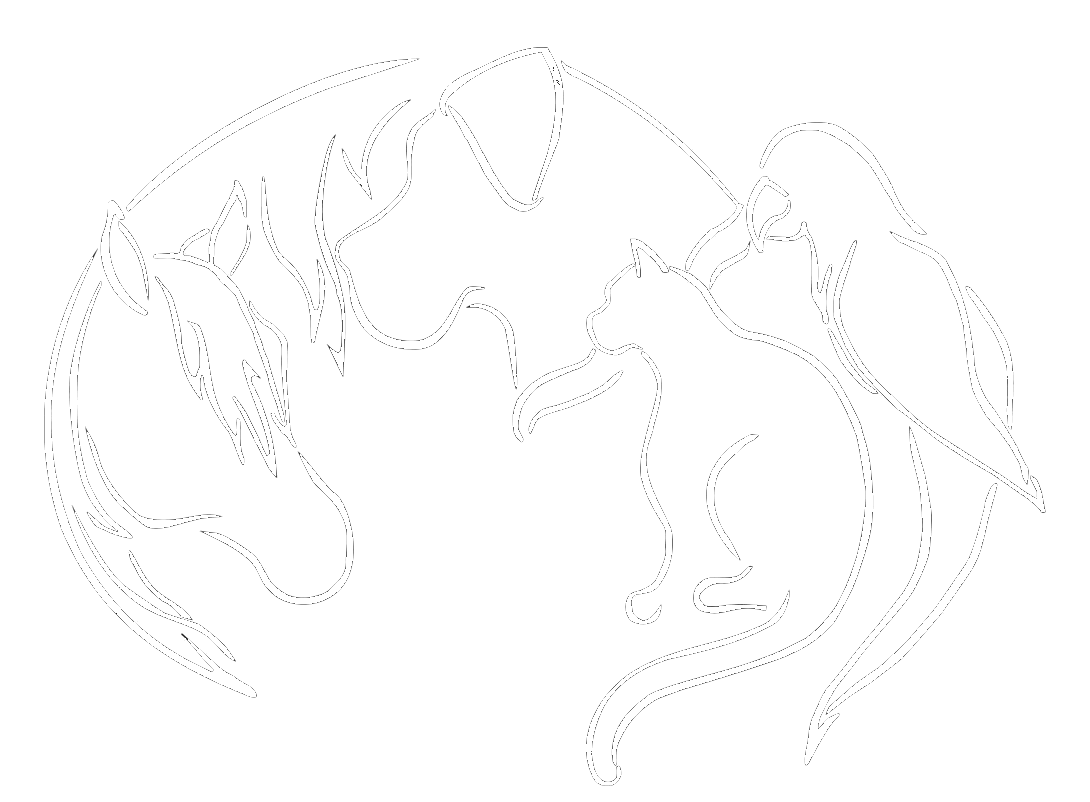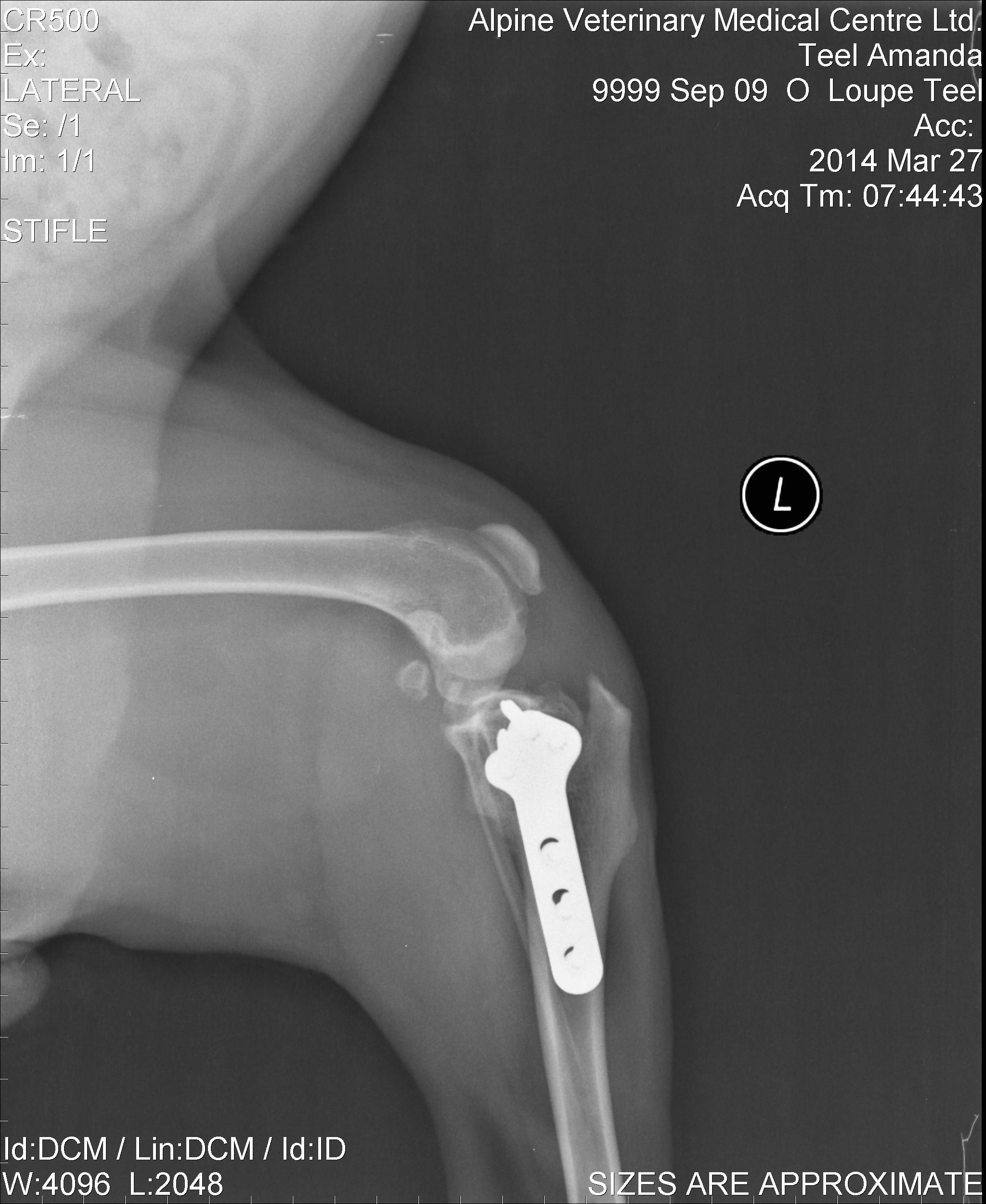caring for your pet after cruciate surgery
There is often post-operative swelling of the knee for 2-7 days after the surgery. This swelling can move down the leg towards the tarsal (ankle) joint and usually peaks 3-5 days following surgery.
Your dog should eat normally and not be in a large amount of pain. The incision should not be getting redder or have any discharge. Please call the clinic to speak with a veterinarian if you have any questions or concerns regarding what is normal following surgery.
Your dog should wear a cone at all times until the external sutures are removed. An exception to this rule can be made if the cone causes issues with balance on trips outside or while eating, but it should be replaced again as soon as possible.
Pain Medication
Your dog will go home on medications for the post-operative period to help control pain and inflammation.
Metacam ® (meloxicam) is a non-steroidal anti-inflammatory medication given to help control pain and inflammation. One dose is usually given to your dog as they are recovering from surgery as an injection, and 4 oral doses are sent home. The dosing frequency for this medication is once every 24 hours. If your dog seems painful after this medication is finished, please call the clinic to speak with a veterinarian.
Tramadol is an opioid-like medication that is used to treat pain. It works synergistically with Metacam ® to provide a higher level of pain control. It comes as a tablet and can be dosed every 8-12 hours depending on the level of pain/discomfort. A common side effect associated with this drug is sedation.
Gabapentin is a medication sometimes used to treat neuropathic (nerve) pain, and can work synergistically with Metacam or other NSAIDs to help provide post-operative pain relief.
Joint Medications
Cartrophen® injections can be started immediately after surgery. They are used to help maintain joint health and can help delay the progression of arthritis within the joint. Dogs typically tolerate these injections very well, and a noticeable improvement is often seen within 4 weeks of starting therapy.
These injections will be invoiced separately when they are given to your dog.
Cartrophen ® injection schedule:
One injection, once weekly for 4 weeks then once monthly for 4 months.
Other Joint Supplements
Omega 3 fatty acids derived from fish oil as well as supplements containing green-lipped mussel extracts can also help manage arthritis and maintain joint health long term.
Glucosamine/chondroitin supplements can also beneficial with slowing the progression of arthritis. Unfortunately, oral human over the counter glucosamine products have limited research supporting their efficacy in managing osteoarthritis in dogs. The quality (purity) and bioavailability (absorption within the body) vary greatly from product to product.
Products that are reliable and trusted in dogs are Cosequin DS ® and Recovery SA ®
If you have any questions regarding a product or dosing of oral joint supplements, please call the clinic and speak with a veterinarian.
Therapeutic Laser Phototherapy
Alpine Veterinary Medical Centre has a class 4 therapeutic laser. Laser therapy is the non-invasive use of laser energy to generate a photochemical response in damaged or dysfunctional tissue. We provide one laser treatment during recovery from surgery to help reduce pain and inflammation in the immediate post-operative period.
Additional laser treatments following surgery during the recovery phase can help reduce pain, inflammation and speed healing. It can also be used to treat arthritis long term by reducing pain and inflammation in the affected joints. If you are interested in laser therapy, please talk to your veterinarian to schedule a series of laser therapy sessions.
Physiotherapy and Activity Schedule
Week 1-2
Immediately following surgery your dog will require strict rest. Walks should be for bathroom breaks only and limited to 5-10 minutes (3-4 times a day). Your dog should be on a leash at all times when outside.
You may need to help your dog walk by using a towel as a sling to support the hind end as they often are adjusting to weight bearing and balancing with 3 legs. To reduce the chance of your dog falling over, the cone can be removed during the short walks. However, it should be replaced immediately upon returning indoors. While inside, the dog should be confined to a small area or large crate to minimize movement. Do not allow your dog to jump on furniture.
Stairs are okay following surgery in medium and large dogs. This should ONLY be done under direct supervision and with the use of a towel sling to support the hind end. Small dogs should be carried up and down stairs for the first 4 weeks.
PROM (Passive Range of Motion) exercises can be started 2-3 days following surgery and should only be performed within your dog’s comfort range. These exercises involve flexion and extension of the hip, knee, and ankle joints of the limb that underwent surgery. Perform 10-15 gentle movements at each joint, 2-3 times a day. If your dog experiences pain or you are unsure of what is tolerable for your dog, please call the clinic to speak with a veterinarian.
Passive Range of Motion Exercises
A general overview of physiotherapy for your dog after cruciate injury surgery
Cold therapy applied to the affected joints may also be started the day following surgery. This helps to reduce swelling and bruising in addition to providing pain relief. A frozen gel pack or bag of frozen peas or corn wrapped in a tea towel can be applied to the joint for 10 minutes, 2-3 times daily. This should be done for 5-7 days following surgery.
You may also perform gentle massage over the leg, starting at the toes and working upward towards the hip. Gentle kneading of the tissue and brushing of your hands over the area can help to stimulate blood flow and reduce swelling and inflammation.
External stitches are removed 14 days following surgery.
Week 3-4
After the stitches are removed the cone collar is no longer required as the incision has healed. At this time, your dog should still only be allowed to go outside for bathroom breaks. Walks can be increased gradually by 5 minutes every week as long as your dog tolerates it and walks should be limited to flat ground with good footing only. Your dog may start to touch the affected leg down for support while outside. NOTE: Your dog is still always on a leash when outside.
Continue PROM (Passive Range of Motion) – 10 SLOW reps 3 times/ day.
Ice Pack knee for 5 – 10 minutes following each PROM Session.
Precede and follow PROM with massage of quads and hamstrings.
Standing weight bearing exercises may be started gradually at week 4. These include 3 legged standing, sit to stand exercises, and weight shifting to the operated leg. Start with 2-3 repetitions of each exercise, 2-3 times a day, and gradually increase.
Two-legged standing exercise
Sit to stand exercise
Weight Shifting Exercises
Week 5-6
For the next two weeks your dog can be allowed more advanced exercises on a leash. Walks should be at 25-35 minutes in length and should be performed mostly on flat ground with good footing. You may start incorporating walks at gentle inclines at week 6.
Continue with standing and weight bearing exercises from weeks 3 and 4. You may also start figure 8 and serpentine walking at this time (3 repetitions, twice daily).
Dog cavaletti (stepping over low poles on the ground) may also be incorporated into the physiotherapy regime to encourage flexion of the knee. Good footing is essential when you are performing this activity.
High stepping over cavaletti poles for dogs helps with balance, stability and flexibility.
Continue PROM and massage every day until the end of Week 6.
Week 7-8
At this point you may introduce slow trotting and incorporate more inclines and declines on your walks, still always on a leash and on good footing.
Work on slowly increasing the number of sit to stand exercises (20-30 per session is the goal)
Week 9-10
Your dog should be kept on a leash at all times until week 10 following surgery to ensure that the repair has had adequate time to heal and become stable. At this point off leash time should be limited to your backyard and supervised. No running or sudden turns should be allowed.
You may allow your dog to swim after week 10, but ensure gentle entry into and out of the water. Do not allow scrambling over rocks or uneven ground and racing into/out of the water.
A good exercise in the water is going from the stand to sit position.
You may also begin to perform 2-legged stands, and backwards and forwards dancing (forelimbs off the ground while moving around) at this time.
Week 10-16
Increase walks (still on a leash) over this period of time until the normal activity of the dog is reached.
Avoid the Dog Park, aggressive play and strenuous exercise until 4 months post-surgery.
Continue physiotherapy exercises and gradually increase activity until full function of the knee returns and your dog appears normal.
We expect your dog to be back to normal function by 4-5 months following surgery.
Please call at any time if you have any questions.

